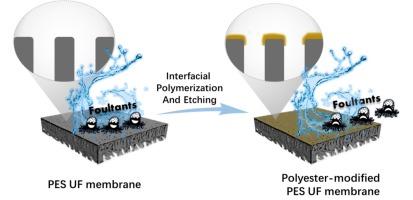界面聚合结合蚀刻:一种新型超滤膜表面改性方法
IF 5.1
3区 工程技术
Q1 CHEMISTRY, APPLIED
引用次数: 0
摘要
本文提出了一种新的超滤膜表面改性方法——界面聚合与蚀刻相结合,以提高超滤膜的分离性能和防污性能。采用聚乙二醇(PG)与三甲酰氯(TMC)界面聚合的方法对聚醚砜(PES)超滤膜进行改性,形成聚酯分离层。随后进行碱性蚀刻,去除大部分聚酯层,留下残余部分,然后用于修饰膜表面。改性后的膜表现出增强的亲水性和减少的表面电荷,从而提高了防污性能。通过扫描电子显微镜(SEM)、原子力显微镜(AFM)、x射线光电子能谱(XPS)、傅里叶变换红外光谱(FTIR)和接触角测量等物理化学表征证实了改性的成功,亲水性也得到了增强。分离性能测试结果表明,改性膜保持了原有的分离性能,同时在引入污染循环后表现出更高的通量回收率。长期稳定性测试的结果表明,改性膜在较长时间内保持其性能,表明其具有实际应用的潜力。本研究结果为提高工业分离过程中超滤膜的性能提供了一条有希望的途径。本文章由计算机程序翻译,如有差异,请以英文原文为准。

Interfacial polymerization combined with etching: A novel surface modification method for ultrafiltration membranes
This study presents a novel surface modification method for ultrafiltration membranes via interface polymerization combined with etching, with the objective of enhancing their separation performance and antifouling properties. Polyethersulfone (PES) ultrafiltration membranes were modified via interfacial polymerization of polyethylene glycol (PG) with trimesoyl chloride (TMC) to form a polyester separation layer. This was followed by alkaline etching, which served to remove the majority of the polyester layer, leaving a residual portion that was then employed to modify the membrane surface. The modified membranes displayed enhanced hydrophilicity and a diminished surface charge, which resulted in an elevated level of antifouling performance. The successful modification of the membranes was confirmed by physicochemical characterizations, including scanning electron microscopy (SEM), atomic force microscopy (AFM), X-ray photoelectron spectroscopy (XPS), Fourier transform infrared spectroscopy (FTIR), and contact angle measurements, which also demonstrated an enhanced hydrophilicity. The results of the separation performance tests demonstrated that the modified membranes retained their original separation properties while exhibiting enhanced flux recovery rates following the introduction of fouling cycles. The results of the long-term stability tests demonstrated that the modified membranes retained their performance over an extended period, indicating their potential for practical applications. The findings of this study offer a promising approach to enhancing the performance of ultrafiltration membranes in industrial separation processes.
求助全文
通过发布文献求助,成功后即可免费获取论文全文。
去求助
来源期刊

Reactive & Functional Polymers
工程技术-高分子科学
CiteScore
8.90
自引率
5.90%
发文量
259
审稿时长
27 days
期刊介绍:
Reactive & Functional Polymers provides a forum to disseminate original ideas, concepts and developments in the science and technology of polymers with functional groups, which impart specific chemical reactivity or physical, chemical, structural, biological, and pharmacological functionality. The scope covers organic polymers, acting for instance as reagents, catalysts, templates, ion-exchangers, selective sorbents, chelating or antimicrobial agents, drug carriers, sensors, membranes, and hydrogels. This also includes reactive cross-linkable prepolymers and high-performance thermosetting polymers, natural or degradable polymers, conducting polymers, and porous polymers.
Original research articles must contain thorough molecular and material characterization data on synthesis of the above polymers in combination with their applications. Applications include but are not limited to catalysis, water or effluent treatment, separations and recovery, electronics and information storage, energy conversion, encapsulation, or adhesion.
 求助内容:
求助内容: 应助结果提醒方式:
应助结果提醒方式:


